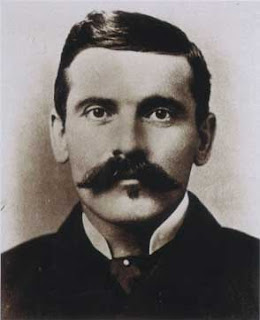 |
| Montana cowboys, c1910 |
Here’s another set of frontier terms garnered from turn of the century novels and stories I’ve been reading. Definitions were discovered in various online dictionaries, as well as searches in
Cassell’s Dictionary of Slang, Dictionary of the American West, The Cowboy Dictionary, The Barnhart Dictionary of Etymology, and
The Shorter Oxford English Dictionary.
arc light = light produced by an electric arc inside a bulb filled with gas, e.g. neon, argon, or xenon. “The man drew out a cigarette case that flashed in colors from the nearby arc-light.” Will Lillibridge,
Ben Blair.
bad cess to = may evil befall. “‘Red Slavin, bad cess to him!’ and her eyes regarded her questioner with renewed anxiety.” Randall Parrish,
Bob Hampton of Placer.
 |
| Angold arc lamp, 1898 |
benedict = a newly married man, especially one who has been long a confirmed bachelor; from the character in Shakespeare’s
Much Ado About Nothing. “Your prediction sounds a bit strong from one who is himself a benedict.” Will Lillibridge,
Ben Blair.
bulge = an advantage. “Of course them fellers has got the bulge; they kin starve us out, maybe they kin smoke us out, and they kin sure make things onpleasant whenever they git their long-range guns to throwin’ lead permiscous.” Randall Parrish,
Bob Hampton of Placer.
duck on a/the rock = a children’s game of tag involving the pitching of stones at a rock. “‘Let's play duck on the rock,’ suggested Florence.” Will Lillibridge,
Ben Blair.
fandango = a ball or dance. “We’ve got them fellers roped and tied, gents, and they simply won’t be ace-high with the ladies of this camp after our fandango is over with.” Randall Parrish,
Bob Hampton of Placer.
 |
| Meadow lark, 1919 |
fill your tea-kettle = bird song. “The meadow-larks, singly or in pairs, announcing their arrival with a guttural ‘tuerk’ and a saucy flit of the tail, or admonishing ‘fill your tea-kettle, fill your tea-kettle’ with a persistence worthy a better cause.” Will Lillibridge,
Ben Blair.
ginger = enliven. “He tried to ginger things up a bit when he was new here.” Will Lillibridge,
Ben Blair.
Jehu = a king of Israel known for riding his chariot furiously; a coach or cab driver who drives fast or recklessly. “She sat comfortably ensconced in the back seat of the old, battered red coach, surrounded by cushions for protection from continual jouncing, as the Jehu in charge urged his restive mules down the desolate vally of the Bear Water.” Randall Parrish,
Bob Hampton of Placer.
overhaul = to catch up with, overtake. “I didn’t know that we’d fail to overhaul you.” Hamlin Garland,
The Moccasin Ranch.
owly = cranky, uncooperative, negative. “Every minute is valuable now. The outlook is owly.” Hamlin Garland,
The Moccasin Ranch.
 |
| Pasteboard book cover |
pasteboard = thin card stock produced by pasting together three or more sheets of paper; used for playing cards. “The man at the left, tall, gaunt, ill-kempt, flicked the pasteboards in his hand to the floor and ground them beneath his heavy boots.” Will Lillibridge,
Ben Blair.
plead the baby act = plead ignorance or inexperience as an excuse for a mistake or wrongdoing. “Of course I believe ye. Not that you’re any too blame good, Bob, but you ain’t the kind what pleads the baby act.” Randall Parrish,
Bob Hampton of Placer.
pre-emptor = someone who acquires or uses land without permission. “Three months dragged out their slow length before the pre-emptors could file and escape from their claims.” Hamlin Garland,
The Moccasin Ranch.
rack-a-bone = an emaciated person or animal, a skeleton. “I was on my way to the store, but when I saw his old rack-a-bone team, I turned off to see you.” Hamlin Garland,
The Moccasin Ranch.
scantling = a timber of relatively slight width and thickness, as a stud or rafter in a house frame. “Bailey went out to the front of the shanty to look at the lantern he had set up on the scantling.” Hamlin Garland,
The Moccasin Ranch.
 |
| Shot tower, by Jesster79 |
shot tower = a building formerly used in the production of shot, in which molten lead was dropped from a great height into water, thus cooling it and forming the shot. “Hills twenty, thirty miles away rose like apparitions, astonishingly magnified. Willows became elms, a settler’s shanty rose like a shot-tower.” Hamlin Garland,
The Moccasin Ranch.
straddlebug = tripod commonly constructed of three planks of wood with a settler’s name attached to notify others that a plot of land was being claimed. “And so at last they came to the land of ‘the straddle-bug’ – the squatters’ watch dog – three boards nailed together (like a stack of army muskets) to make a claim.” Hamlin Garland,
The Moccasin Ranch.
strawboard = a coarse yellow cardboard made of straw pulp; used in hardcover bookbinding. “Mr. Demilt had written to his firm explaining the advantages of starting a straw-board factory in Fairfield.” Henry Wallace Phillips,
Red Saunders.
tidy = a small covering, usually ornamental, placed on the backs and arms of upholstered furniture to prevent wear or soiling; an antimacassar. “It’s more fun than working red poppies on tidies – that’s about all they’ll let you do back East.” Hamlin Garland,
The Moccasin Ranch.
 |
| Weary Willie (far right), 1898 |
Weary Willy = tramp character created by British cartoonist Tom Browne (1870-1910). “I'm not a Weary Willie. I prefer to earn my dole first.” Will Lillibridge,
Ben Blair.
yellow boy = gold coin; originally a gold guinea. “There’ll be another yellow boy waiting when you come.” Randall Parrish,
Bob Hampton of Placer.
Image credits:
Weary Willie, lambiek.net
All others, Wikimedia Commons:
Meadow lark illustration from
The Burgess Bird Book for Children by Louis Agassiz Fuertes (1874-1927)
Pasteboard prayer book cover by By Wikipedia Loves Art participant "shooting_brooklyn"
Coming up: “Doc” (1971)













































